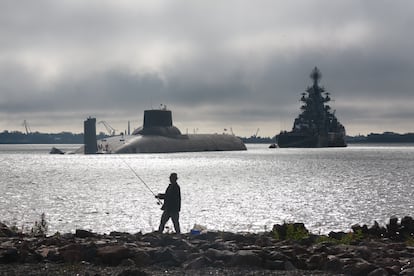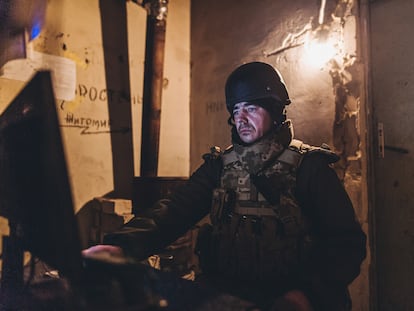Russia deploys nuclear-armed ships for first time in 30 years, report says
According to Norwegian intelligence services, Moscow has fitted its Northern Fleet with tactical nuclear weapons, increasing the risk of an escalation due to misunderstandings between Moscow and NATO


The risk of a nuclear escalation on Russia’s borders with NATO countries continues to rise. With its army worn down by the offensive in Ukraine, Moscow has withdrawn troops from the area and replaced them with tactical nuclear weapons on its Northern Fleet ships for the first time since the collapse of the Soviet Union, according to Norwegian military intelligence.
Oslo fears that the presence of these warheads poses “a particularly serious threat in various scenarios that may involve countries of the Atlantic Alliance,” since mutual mistrust “has raised the possibility of unwanted events and misunderstandings between Russia and NATO.”
The Norwegian Defense Ministry’s annual report, Fokus 2023, confirms that a central part of Russia’s nuclear capability has been deployed on the surface ships and submarines of the Northern Fleet. According to the Norwegian media, the last time that warships armed with nuclear weapons departed from the Arctic port of Severomorsk was back in the golden age of the Russian navy, during the Cold War.
“With a weakened conventional capability, the importance of nuclear weapons has increased significantly for Russia,” the report says, adding that Moscow can also count on other types of warfare through anti-satellite weapons, cyber tools and its special forces for sabotaging submarine infrastructure.
The report warns that nobody should rule out the possibility that “a local war could turn into a larger conflict” directly involving Russia, the US and NATO. According to this information, Russia had planned the complete occupation of Ukraine and its ambition was to seize as much intact infrastructure as possible.
Russian authorities have repeatedly warned about the possibility of nuclear war if their other plans fail. President Vladimir Putin warned in September 2022 that he would defend the annexed territory “with all means” at his disposal, and the deputy head of the Security Council and ex-president, Dmitry Medvedev, stated in early January that “the defeat of a nuclear power in a conventional war can lead to the outbreak of a nuclear war.”
Preparing for ground offensive
Additionally, Western intelligence sources said on Tuesday that Russia is amassing aircraft near the Ukrainian border, an indication that Moscow is preparing to send air support for its ground offensive, the Financial Times reported. Fears of an impending air war have prompted Western allies to prioritize rapid shipments of air defense assets and artillery munitions to Kyiv, according to Western officials, as a response to Moscow’s shift in focus as the war enters a new phase.
Severomorsk is located on the Kola Peninsula, a region of great strategic importance, since the Arctic routes will become very important in the future due to climate change. The region adjoins a NATO country, Norway, and a new candidate, Finland. Despite the fact that the Kremlin argued that its offensive on Kyiv was tied to a hypothetical NATO threat against Russia, Moscow has reduced its military presence in that area and in the Baltic Sea in order to reinforce its positions in Ukraine.
The defeat of a nuclear power in a conventional war can lead to the outbreak of a nuclear warEx-president of Russia Dmitry Medvedev
“The land forces of the Kola Peninsula have been reduced to a fifth of their numbers prior to the invasion of Ukraine,” says the Norwegian intelligence report. “Russia’s conventional forces have been significantly weakened by its offensive in Ukraine and a large part of what remains is tied up in the war. Among other problems, [Russia] has spent three-quarters of its modern ground-based missiles in Ukraine.”
But the report concludes that this does not make Moscow any less dangerous. “Russia has large reserves of military equipment, especially the oldest [...], its nuclear capabilities are the same as before the war, and the air and naval forces are still essentially intact.”
The Norwegian report underscored the deployment to the Northern Fleet of some of Russia’s new generation weapons. According to Washington, both the Tsirkon hypersonic missiles and the Kalibr precision rockets can carry nuclear warheads, although it has so far not accused Moscow of equipping its ships with these weapons.
These missiles have featured in some of the attacks against Ukrainian civilian infrastructure in recent months. According to the Ukrainian Defense Ministry, 11 Russian ships are currently carrying out combat missions in the Black Sea, two of them equipped with Kalibr missile launchers.
Until a week ago, the Russian fleet was sailing in a sea free of NATO ships, as US and European vessels left the area before the invasion launched on February 24, 2022. But Western ships are back: earlier this month, a destroyer from the US Sixth Fleet crossed the Bosphorus for the first time since Putin launched the war.
Sign up for our weekly newsletter to get more English-language news coverage from EL PAÍS USA Edition
Tu suscripción se está usando en otro dispositivo
¿Quieres añadir otro usuario a tu suscripción?
Si continúas leyendo en este dispositivo, no se podrá leer en el otro.
FlechaTu suscripción se está usando en otro dispositivo y solo puedes acceder a EL PAÍS desde un dispositivo a la vez.
Si quieres compartir tu cuenta, cambia tu suscripción a la modalidad Premium, así podrás añadir otro usuario. Cada uno accederá con su propia cuenta de email, lo que os permitirá personalizar vuestra experiencia en EL PAÍS.
¿Tienes una suscripción de empresa? Accede aquí para contratar más cuentas.
En el caso de no saber quién está usando tu cuenta, te recomendamos cambiar tu contraseña aquí.
Si decides continuar compartiendo tu cuenta, este mensaje se mostrará en tu dispositivo y en el de la otra persona que está usando tu cuenta de forma indefinida, afectando a tu experiencia de lectura. Puedes consultar aquí los términos y condiciones de la suscripción digital.
More information
Archived In
Últimas noticias
Most viewed
- Reinhard Genzel, Nobel laureate in physics: ‘One-minute videos will never give you the truth’
- Oona Chaplin: ‘I told James Cameron that I was living in a treehouse and starting a permaculture project with a friend’
- Pablo Escobar’s hippos: A serious environmental problem, 40 years on
- Why we lost the habit of sleeping in two segments and how that changed our sense of time
- Chevy Chase, the beloved comedian who was a monster off camera: ‘Not everyone hated him, just the people who’ve worked with him’










































